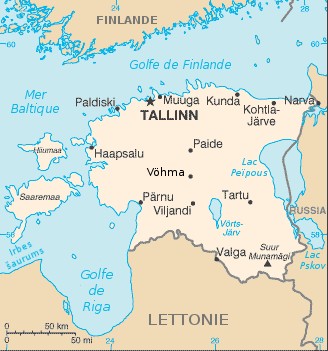This is an old revision of this page, as edited by 212.59.62.19 (talk) at 12:07, 5 February 2003. The present address (URL) is a permanent link to this revision, which may differ significantly from the current revision.
Revision as of 12:07, 5 February 2003 by 212.59.62.19 (talk)(diff) ← Previous revision | Latest revision (diff) | Newer revision → (diff)
The Republic of Estonia is a small country in Northeastern Europe, bordering the Baltic Sea to the west, the Gulf of Finland to the north, and sharing a land border with its fellow Baltic state Latvia to the south and with Russia to the east.
| ||||
| National motto: None | ||||
| Official language | Estonian | |||
| Capital | Tallinn | |||
| President | Arnold Rüütel | |||
| Prime Minister | Siim Kallas | |||
| Area - Total - % water | Ranked 130th 45,226 km² 4.56% | |||
| Population
- Density | Ranked 145th
31/km² | |||
| Independence
- Recognised | From the Soviet Union
February 2, 1920 | |||
| Currency | Estonian kroon | |||
| Time zone | UTC +2 | |||
| National anthem | Mu isamaa, mu õnn ja rõõm | |||
| Internet TLD | .EE | |||
| Calling Code | 372 | |||
History
Main article: History of Estonia
Estonia has been populated by the native Finno Ugric Estonians since prehistory. It was first christianised when the German Sword Brethren and Denmark conquered the land by 1227. Subsequent foreign powers that controlled Estonia at various times included Denmark, Sweden, Poland and finally Russia.
Following the collapse of imperial Russia during the October Revolution, Estonia declared its independence as a republic on February 24, 1918. Forcibly incorporated into the Soviet Union in June, 1940, it regained its freedom in August 20, 1991 with the collapse of the Soviet Union. August 20 remains a national holiday in Estonia because of this.
Since the last Russian troops left on August 31 1994, Estonia has been free to promote economic and political ties with Western Europe. It is seeking membership of NATO and Estonia opened accession negotiations with European Union in 1998 and is planning to join in 2004.
Politics
Main article: Politics of Estonia
Estonia is a constitutional democracy, with a directly elected president (elections every five years) and a unicameral parliament. The government or the executive branch is formed by the prime minister, nominated by the president, and a total of 15 ministers. The government is appointed by the president after approval by the parliament.
Legislative power lies with the unicameral parliament, the Riigikogu or State Assembly, which holds 101 seats. Members are elected by popular vote to serve four-year terms. The supreme judiciary court is the National Court or Riigikohus, with 17 justices whose chairman is appointed by the parliament for life on nomination by the president.
Counties
Main article: Counties of Estonia
Estonia numbers 15 main administrative subdivisions, called counties (maakonnad, singular - maakond):
- Harjumaa
- Hiiumaa
- Eastern Virumaa (Ida-Virumaa)
- Järvamaa
- Jögevamaa
- Läänemaa
- Western Virumaa (Lääne-Virumaa)
- Pärnumaa
- Pölvamaa
- Raplamaa
- Saaremaa
- Tartumaa
- Valgamaa
- Viljandimaa
- Vörumaa
Geography
Main article: Geography of Estonia

Between 57.3 and 59.5 latitude and 21.5 and 28.1 longitude, Estonia lies on the eastern shores of the Baltic Sea on the level northwestern part of the rising east European platform. Average elevation reaches only 50 m.
Oil shale (or kukersite) and limestone deposits, along with forests which cover 47% of the land, play key economic roles in this generally resource-poor country. Estonia boasts over 1,400 lakes (most very small, with the largest, Lake Peipsi, being 3,555 km²), numerous bogs, and 3,794 kilometers of coastline marked by numerous bays, straits, and inlets. The number of islands and islets is estimated at some 1,500 with two large enough to constitute their own counties, Saaremaa and Hiiumaa.
Its highest point is the Suur Munamägi in the southeastern corner of the country.
Economy
Main article: Economy of Estonia
In 1999, Estonia experienced its worst year economically since it regained independence in 1991 largely because of the impact of the August 1998 Russian financial crisis. Estonia joined the WTO in November 1999 - the second Baltic state to join - and continued its EU accession talks. Privatisation of energy, telecommunications, railways, and other state-owned companies is a continuing process. Estonia expects to complete its preparations for EU membership by the end of 2002 and is one of the economic front-runners of those seeking entry in 2004.
Demographics
Main article: Demographics of Estonia
About two thirds of the population consist of Estonians, with the rest from other former Soviet republics, mainly Russia, who predominantly live in the capital Tallinn. There is also a small group of Finnish descent.
The country's official language is Estonian, which is closely related to Finnish. Russian is also widely spoken.
A majority of the Estonians is Lutheran, whereas the Russian minority is Eastern Orthodox.
Culture
Main article: Culture of Estonia
Miscellaneous topics
- Communications in Estonia
- Transportation in Estonia
- Military of Estonia
- Foreign relations of Estonia
- Tourism in the Baltics
- List of cities in Estonia
External links
- Official State Website (eRiik) - in English
- Estonia Country Guide